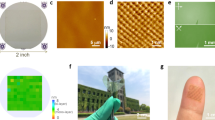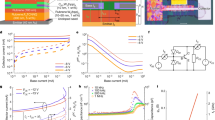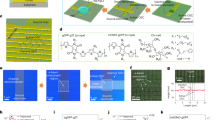Abstract
The prospect of using low-temperature processable organic semiconductors to implement transistors, circuits, displays and sensors on arbitrary substrates, such as glass or plastics, offers enormous potential for a wide range of electronic products1. Of particular interest are portable devices that can be powered by small batteries or by near-field radio-frequency coupling. The main problem with existing approaches is the large power consumption of conventional organic circuits, which makes battery-powered applications problematic, if not impossible. Here we demonstrate an organic circuit with very low power consumption that uses a self-assembled monolayer gate dielectric and two different air-stable molecular semiconductors (pentacene and hexadecafluorocopperphthalocyanine, F16CuPc). The monolayer dielectric is grown on patterned metal gates at room temperature and is optimized to provide a large gate capacitance and low gate leakage currents. By combining low-voltage p-channel and n-channel organic thin-film transistors in a complementary circuit design, the static currents are reduced to below 100 pA per logic gate. We have fabricated complementary inverters, NAND gates, and ring oscillators that operate with supply voltages between 1.5 and 3 V and have a static power consumption of less than 1 nW per logic gate. These organic circuits are thus well suited for battery-powered systems such as portable display devices2 and large-surface sensor networks3 as well as for radio-frequency identification tags with extended operating range4.
This is a preview of subscription content, access via your institution
Access options
Subscribe to this journal
Receive 51 print issues and online access
$199.00 per year
only $3.90 per issue
Buy this article
- Purchase on Springer Link
- Instant access to full article PDF
Prices may be subject to local taxes which are calculated during checkout




Similar content being viewed by others
References
Zhou, L. et al. All-organic active matrix flexible display. Appl. Phys. Lett. 88, 083502 (2006)
Gelinck, G. H. et al. Flexible active-matrix displays and shift registers based on solution-processed organic transistors. Nature Mater. 3, 106–110 (2004)
Someya, T. et al. Conformable, flexible, large-area networks of pressure and thermal sensors with organic transistor active matrixes. Proc. Natl Acad. Sci. USA 102, 12321–12325 (2005)
Baude, P. et al. Pentacene-based radio-frequency identification circuitry. Appl. Phys. Lett. 82, 3964–3966 (2003)
Collet, J., Tharaud, O., Chapoton, A. & Vuillaume, D. Low-voltage, 30 nm channel length, organic transistors with a self-assembled monolayer as gate insulating films. Appl. Phys. Lett. 76, 1941–1943 (2000)
Halik, M. et al. Low-voltage organic transistors with an amorphous molecular gate dielectric. Nature 431, 963–966 (2004)
Yoon, M. H., Facchetti, A. & Marks, T. J. σ-π molecular dielectric multilayers for low-voltage organic thin-film transistors. Proc. Natl Acad. Sci. USA 102, 4678–4682 (2005)
Park, Y. D. et al. Low-voltage polymer thin-film transistors with a self-assembled monolayer as the gate dielectric. Appl. Phys. Lett. 87, 243509 (2005)
Ulman, A. An Introduction to Ultrathin Films: From Langmuir-Blodgett to Self-Assembly (Academic Press, Boston, 1991)
Folkers, J. P., Gorman, C. B., Laibinis, P. E., Buchholz, S. & Whitesides, G. M. Self-assembled monolayers of long-chain hydroxamic acids on the native oxides of metals. Langmuir 11, 813–824 (1995)
Bram, C., Jung, C. & Stratmann, M. Self assembled molecular monolayers on oxidized inhomogeneous aluminum surfaces. Fresenius J. Anal. Chem. 358, 108–111 (1997)
Goetting, L. B., Deng, T. & Whitesides, G. M. Microcontact printing of alkanephosphonic acids on aluminum: Pattern transfer by wet chemical etching. Langmuir 15, 1182–1191 (1999)
Kim, K. D. & Song, C. K. Low voltage pentacene thin film transistors employing a self-grown metal-oxide as a gate dielectric. Appl. Phys. Lett. 88, 233508 (2006)
Wu, C. C. et al. A 90-nm CMOS device technology with high-speed, general-purpose, and low-leakage transistors for system on chip applications. 2002 International Electron Devices Meeting Technical Digest 65–68 (The Institute of Electrical and Electronics Engineers, Piscataway, New Jersey, 2002)
Fontaine, P. et al. Octadecyltrichlorosilane monolayers as ultrathin gate insulating films in metal-insulator-semiconductor devices. Appl. Phys. Lett. 62, 2256–2258 (1993)
Robertson, J. High dielectric constant oxides. Eur. Phys. J. Appl. Phys. 28, 265–291 (2004)
Yang, S. Y., Shin, K. & Park, C. E. The effect of gate dielectric surface energy on pentacene morphology and organic field-effect transistor characteristics. Adv. Funct. Mater. 15, 1806–1814 (2005)
Hulea, I. N. et al. Tunable Fröhlich polarons in organic single-crystal transistors. Nature Mater. 5, 982–986 (2006)
Bao, Z., Lovinger, A. & Brown, J. New air-stable n-channel organic thin film transistors. J. Am. Chem. Soc. 120, 207–208 (1998)
de Oteyza, D. G. et al. Controlled enhancement of the electron field-effect mobility of F16CuPc thin-film transistors by use of functionalized SiO2 substrates. Appl. Phys. Lett. 87, 183504 (2005)
Ling, M. M. & Bao, Z. Copper hexafluorophthalocyanine field-effect transistors with enhanced mobility by soft contact lamination. Org. Electron. 7, 568–575 (2006)
Yoon, M. H., Yan, H., Facchetti, A. & Marks, T. J. Low-voltage organic field-effect transistors and inverters enabled by ultrathin cross-linked polymers as gate dielectrics. J. Am. Chem. Soc. 127, 10388–10395 (2005)
De Vusser, S., Steudel, S., Myny, K., Genoe, J. & Heremans, P. Low voltage complementary organic inverters. Appl. Phys. Lett. 88, 162116 (2006)
Crone, B. K. et al. Design and fabrication of organic complementary circuits. J. Appl. Phys. 89, 5125–5132 (2001)
Jones, B. A. et al. High-mobility air-stable n-type semiconductors with processing versatility: Dicyanoperylene-3,4:9,10-bis(dicarboximides). Angew. Chem. Int. Edn Engl. 43, 6363–6366 (2004)
Klauk, H. et al. Pentacene organic transistors and ring oscillators on glass and on flexible polymeric substrates. Appl. Phys. Lett. 82, 4175–4177 (2003)
Acknowledgements
Partial financial support (J.P. and M.H.) was provided by the Deutsche Forschungsgemeinschaft.
Author information
Authors and Affiliations
Corresponding author
Ethics declarations
Competing interests
Reprints and permissions information is available at www.nature.com/reprints. The authors declare no competing financial interests.
Supplementary information
Supplementary Notes
This file contains Supplementary Notes with details on the film deposition and patterning methods, thin film characterization, and device and circuit manufacturing process and Supplementary figures S1-S12 showing results of the X ray reflectivity and impedance spectroscopy measurements and of the electrical characterization of the transistors, circuits, and test structures. (PDF 748 kb)
Rights and permissions
About this article
Cite this article
Klauk, H., Zschieschang, U., Pflaum, J. et al. Ultralow-power organic complementary circuits. Nature 445, 745–748 (2007). https://doi.org/10.1038/nature05533
Received:
Accepted:
Issue Date:
DOI: https://doi.org/10.1038/nature05533
This article is cited by
-
Low Voltage a-IGZO Thin Film Transistor Using Tantalum Oxide by Thermal Oxidation
Electronic Materials Letters (2024)
-
Elastic integrated electronics based on a stretchable n-type elastomer–semiconductor–elastomer stack
Nature Electronics (2023)
-
Organic bipolar transistors
Nature (2022)
-
Optimisation of geometric aspect ratio of thin film transistors for low-cost flexible CMOS inverters and its practical implementation
Scientific Reports (2022)
-
Monolayer molecular crystals for low-energy consumption optical synaptic transistors
Nano Research (2022)
Comments
By submitting a comment you agree to abide by our Terms and Community Guidelines. If you find something abusive or that does not comply with our terms or guidelines please flag it as inappropriate.



